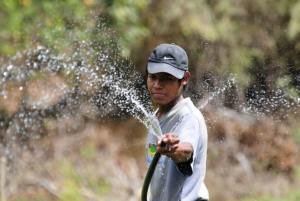5 Facts About Climate Change in Central America

The effects of climate change are more apparent in some areas than others. Central America is one of these areas with drought, high temperatures and floods contributing to agricultural problems and a rise in migration out of the region and into the U.S. These five facts about climate change in Central America provide a glimpse of how it affects the country and the people who live there.
5 Facts About Climate Change in Central America
- Drought: In 2014, climate change in Central America took the shape of a severe drought that plagued the residents of Central America’s dry corridor. In the same year, the U.S. saw an increase in migrants from that region. As the drought persists, high numbers of Central American migrants continue to arrive at the southern border of the U.S., because they cannot sufficiently feed their families. The summer of 2018 included severe drought, and 100,000 Honduran families and two million residents across the Northern Triangle were at risk of malnutrition. The governments of the three Northern Triangle countries entered a state of emergency. The drought was especially destructive to Honduran farmers, many of whom are subsistence farmers living in poverty. Rural Honduran farmers could not easily access the agricultural resources necessary to combat the effects of the drought.
- Food Insecurity: In the aftermath of the summer 2018 drought, two million Central Americans were at risk of food insecurity. The region especially suffered from the impact of the 2018 drought as it still had not recovered from droughts that took place from 2014 to 2016. In 2018, Honduras lost 80 percent of its bean and maize crops. Honduras, Guatemala and El Salvador lost a total of 281,000 hectares of beans and maize.
- The Northern Triangle: Most Central American migrants arriving in the U.S. are from the Northern Triangle. The effects of climate change on the region are becoming increasingly severe. Predictions determine that temperatures there will increase by as much as two degrees by 2050, following increases that have already taken place since 1950. Flooding and prolonged periods of drought accompany the current rise in temperature and will become more severe as temperatures rise. USAID studies predict that some areas of Honduras will see a 60 percent increase in flooding and that Guatemala’s rainfall levels will become dangerously low within the next 10 years. The same studies predict that El Salvador’s coastline will shrink by as much as 28 percent within the next 100 years. One can link the current rise in migration to the effects of climate change in Central America.
- Summer 2018 Droughts: The intensity of the summer 2018 droughts can partly explain the size of the 2018 wave of Central American migrants sometimes referred to as the migrant caravan. In rural areas, a lack of irrigation systems made the drought especially disastrous. According to officials from U.S. Customs and Border Protection, crop failure was a fundamental reason for migration from Central America in 2018. Migrants left Central America to escape poverty and gang violence, but they also left to escape the effects of climate change.
- Agricultural Reform: USAID initiatives in Central America emphasize agricultural reform. USAID combats the effects of climate change in Central America by providing farmers with what they need to deal with droughts and floods. Thanks to initiatives like Feed the Future, 98.7 thousand Guatemalan agricultural producers implemented new technology and farming techniques in 2017. In the same year, 45,000 Honduran agricultural producers implemented new technology and farming techniques. Feed the Future also provided Honduran farmers with the resources and training needed to allow for increased crop diversity and animal agriculture. Diversity and reduced reliance on crops like corn and beans are vital to maintaining the region’s agricultural economy in the face of climate change.
Climate change in Central America is already causing serious problems and will continue to do so in the future. On a positive note, USAID and others are cooperating with Central American governments to respond to the changes taking place. Countries in the area are already implementing innovative, agriculture-based solutions. The efforts of aid organizations will continue to be vital as the global climate continues to change.
– Emelie Fippin
Photo: Flickr
